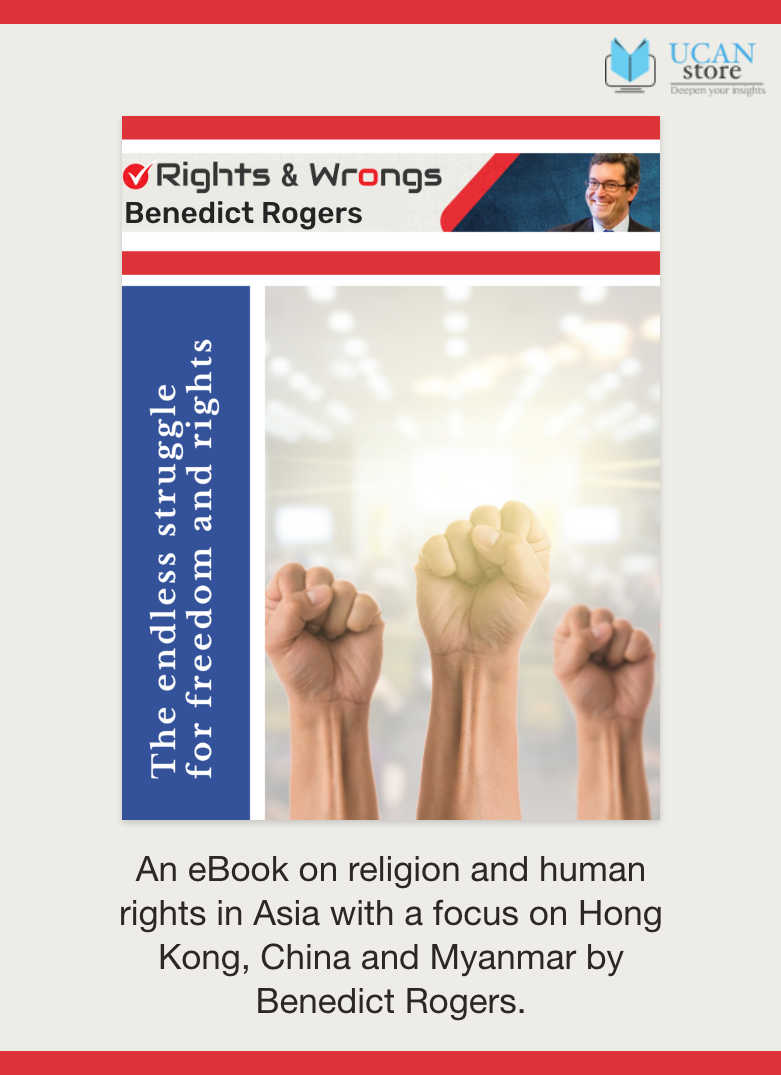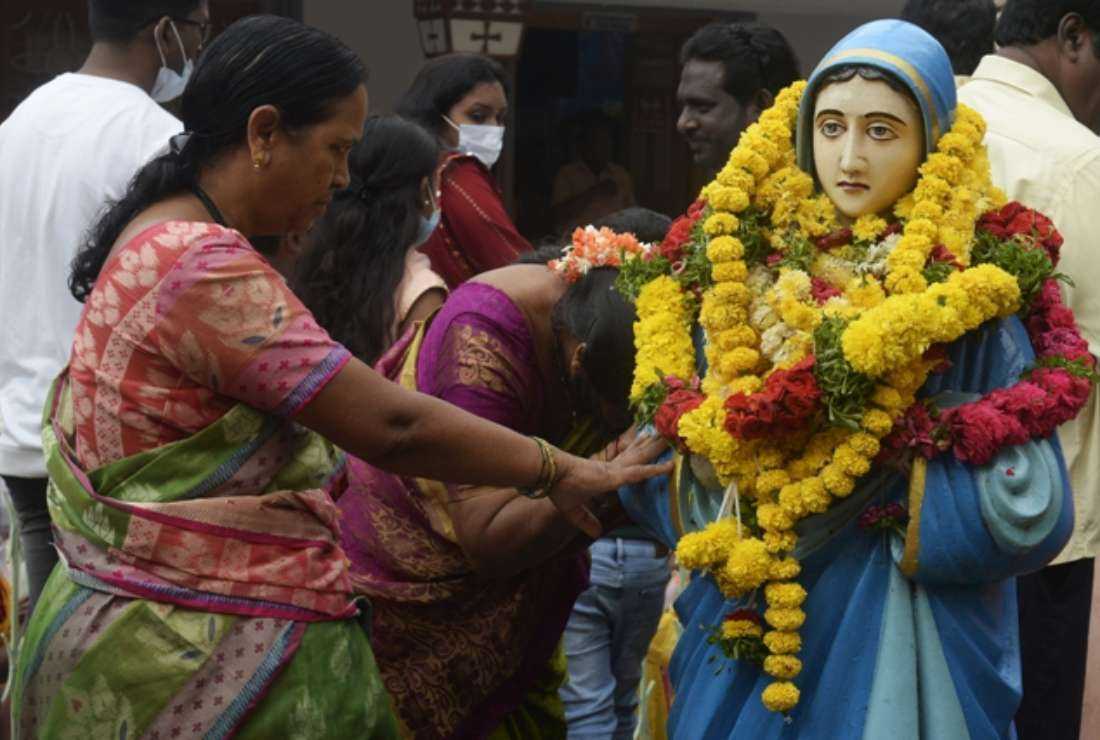
Mary stands as an inter-religious bridge who brings together the most diverse devotees across the continent

Catholic devotees offer prayers at a statue of the Virgin Mary during the annual feast of the Nativity of the Blessed Virgin Mary at the Shrine of Our Lady of Health in Hyderabad on Sept 8, 2022. (Photo: AFP)
In 1498, Vasco de Gama became the first European explorer to arrive in Asia by sea when he landed in Calicut (Kerala, India), and with the Portuguese conquest of Goa in 1510, a new chapter began in the history of Christianity in Asia.
Though it is generally believed that the Portuguese were the first Europeans to arrive in India, scholars have acknowledged that the first Europeans to arrive in India were actually Italian Franciscan missionaries, who arrived at Quilon (Kollam) on the Kerala coast in the early 13th century. However, they at least partially, traveled through land.
Supported sometimes by the pope and other times only on their own initiative, the minor friars were probably the most daring missionaries and explorers of the 13th century in the heart of Asia: China and India. Numerous stories have come down to us about their travels, where they reported important cultural perceptions of the towns they visited.
In 1245, Giovanni di Pian di Carpine was sent by Pope Innocent IV as ambassador to the Mongol Khan. He returned to Italy and wrote his account "Ystoria Mongolorum," one of the first versions of a Western man about these distant lands. Friar Guillermo de Rubruck was another Franciscan who in the 12th century was equally notable for his cultural perceptions of the people of Asia.
He marched towards the Crimea with the intention of spiritually assisting the Christian prisoners of the Tartars. In 1251 he was in Karakorum where he established contact with the Great Khan. He stayed in this city for six months serving the European community made up of artisans in the service of Mongols. After his return in 1254, he wrote the "Intineraru," an account of his voyage.Nevertheless, the major encounter with Christianity came in the 16th century with the arrival of the Portuguese, in India and Southeast Asia. For the Portuguese, trade, conquest and Christianization went hand in hand.
"The Franciscans were the first to establish themselves in Goa after its conquest"
Goa, which the Portuguese first gained control of in 1510, formed the Asian center of their overseas activities. The start of organized Catholic missions in Asia can be traced to the Portuguese conquest of Goa.
When they reached Goa, the Portuguese realized the exceptional importance of the spice trade. Goa's first Portuguese viceroy, Alfonso de Albuquerque, saw that he could only take this commerce away from the Arabs and Turks if he could capture Malacca and find the way to the Isles of Spice. In 1511, Malacca fell into the hands of the Portuguese, and in December of the same year, Albuquerque sent an expedition in search of the Moluccas.
The Portuguese sailed along the coast of Sumatra, Java, Bali, Lombok, Sumbawa, and Flores, where they turned northwards, and reached Banda in the middle of 1512. With this voyage to the Moluccas began the contact between the Portuguese and the Indonesians. These contacts took different forms such as military, commercial and religious.
Among the religious orders, the Franciscans and Dominicans accompanied the first expeditions of the Portuguese to the East from 1498. The Franciscans were the first to establish themselves in Goa after its conquest. Friar Antonio de Louro founded the Monastery of San Francis of Assisi which became the head of the Franciscan Institutions in the whole of the East. In the middle of the 15th century, the Franciscans also established their province of the Mother of God with their provincial house at Daugim, in Goa.
The Jesuits came to Goa in 1542 headed by St. Francis Xavier, the great Apostle of the East and patron of the missions. Within the span of ten years, he spread his activities far and wide in places where the Catholic Church had not been known before; on the fishery coast of South India, in Ceylon, Mylapore, Bassain, Moluccas, Malacca, Japan, and died on Sanchian (Sangchewan) Island off the coast of China.
The missionaries who disembarked in Asia brought with them many images and statues of the Virgin Mary. They promoted devotion to Our Lady as they were all fervent devotees of different Marian cults: the Franciscans and Jesuits of the Immaculate Conception, the Dominicans of the Virgin of the Rosary. So, Mary’s image would exert a remarkable influence in Asia during the 16th century and play a central role in the Church’s mission to evangelize and civilize the masses during the following centuries.
Not only religious orders were fervent followers of Mary, but Portuguese sailors also brought images of the Our Lady during their voyages. The devotion to Our Lady of Navigators, also known as Our Lady of Seafarers, Nossa Senhora dos Navegantes, started in the 15th century by Europeans, especially the Portuguese navigators, praying for a safe return to their homes.
They saw the Virgin Mary as their protector during storms and other hazards. This title given to the Virgin Mary is a widespread devotion in South America, especially in Portuguese colonies. Several churches in Brazil are dedicated to Our Lady of Navigators.
The most important sanctuary dedicated to Mary in South India is that of Our Lady of Health in Velankanni. According to the legend, a Portuguese ship caught in a storm at sea was saved by invoking the help of Mary. The church of Our Lady of Health was built in Velankanni to fulfill the vow made by the sailors.
Besides, Our Lady of the Conception became the patron saint of the kingdom of Portugal in 1640. She was the nation’s true sovereign. Her cult, under the above designation, was given a boost by the Council of Trent. Devotion to Our Lady of Conception thus grew throughout the 18th century giving rise to the fabrication of a large number of wooden and ivory images.
"A characteristic feature of popular devotion to the Virgin Mary in Asia is that it tends to transcend religious affiliations and cultures"
The ease with which ivory was imported from Siam, Cambodia, China, and especially Ceylon led to the production of an increased number of ivory images of the Virgin. Ivory was considered the ideal material for images of the Virgin Mary, being as it is, white and precious. Venerated in private oratories — hence their reduced size — they were held to provide indispensable personal protection. That they are the work of local artists is often given away by the Indian features, the decoration of tunics and cloaks,s or the style of their plinths.
After the Portuguese lost their commercial supremacy in the East, the British East India Company took over. The Portuguese left, but the Virgin Mary stayed, adapted and transformed. She wore different dresses and changed her look, she appeared in different places, in the forest (Our Lady of Lavang), in caves (Goa Maria Sendangsono, Goa Maria Kerep), and on the beach (Our Lady of Larantuka ). She intervened, helping in disastrous situations like plagues, famine (Our Lady of Health, Bangalore), and shipwrecks (Our Lady of Bandel, Our Lady of Chindaaththirai).
She is not only worshipped in South India and Southeast Asia but also in China, Japan, the Philippines, and pilgrims travel a long way in search of the Virgin Mary's blessings in all her sanctuaries around Asia.
A characteristic feature of popular devotion to the Virgin Mary in Asia is that it tends to transcend religious affiliations and cultures and she is venerated by Hindus, Muslims, Zoroastrians, Buddhists, and Taoist devotees. She transcends religious boundaries.
It seems paradoxical that in an intra-Christian setting, Mary has always been viewed as an obstacle to the mutual understanding between Catholics and Protestants, whereas in many inter-religious milieus, Mary tends to be very much a unifying symbol. Mary stands as an inter-religious bridge that brings together the most diverse devotees.It was this role of Mary as an inter-religious bridge in Asia that encouraged the Centre for Marian Studies (UK) and the Initiative for the Study of Asian Catholics (Singapore) to organize an online research conference on: “More Universal Than Catholicism? Mary Among Asian Religions.”
The May 10-12 conference will gather several scholars who investigate the many ways Mary is understood in Asia and in places where Asian emigrants spread their Marian devotions. What are the ritual practices, festivals, and artistic expressions related to Mary and what is her position in tourism discourse and practice?
These and other significant topics will be explored during this three-day conference that will call attention to the contemporary forms and meaning of the devotion to the Our Lady in Asia, with an attempt to demonstrate how the cult of Mary is still very much alive both at a popular and theoretical level.*Patrizia Granziera, is a professor of Art History at the University of Morelos, Cuernavaca, Mexico. The views expressed in this article are those of the author and do not necessarily reflect the official editorial position of UCA News.
Help us keep UCA News independent
The Church in Asia needs objective and independent journalism to speak the truth about the Church and the state.
With a network of professionally qualified journalists and editors across Asia, UCA News is just about meeting that need. But professionalism does not come cheap. We depend on you, our readers, to help maintain our independence and seek that truth.
A small donation of US$2 a month would make a big difference in our quest to achieve our goal.

Share your comments